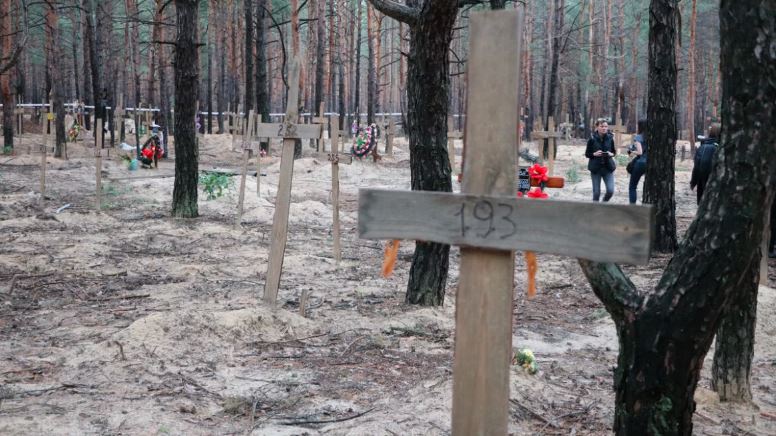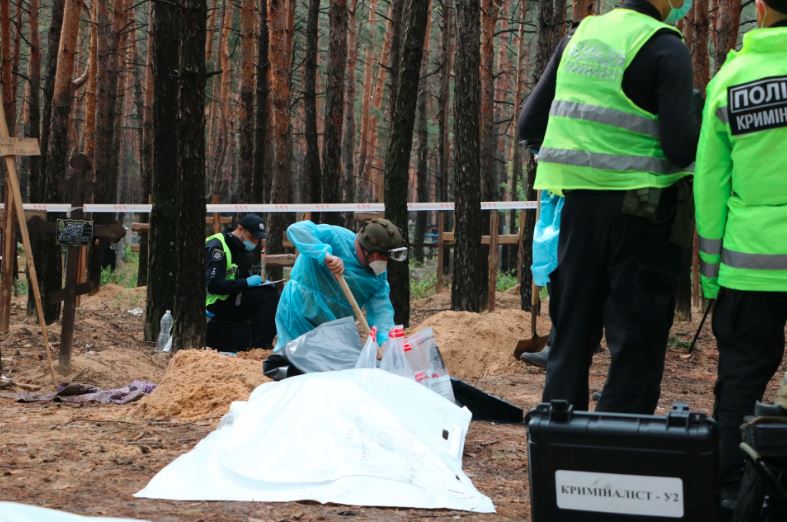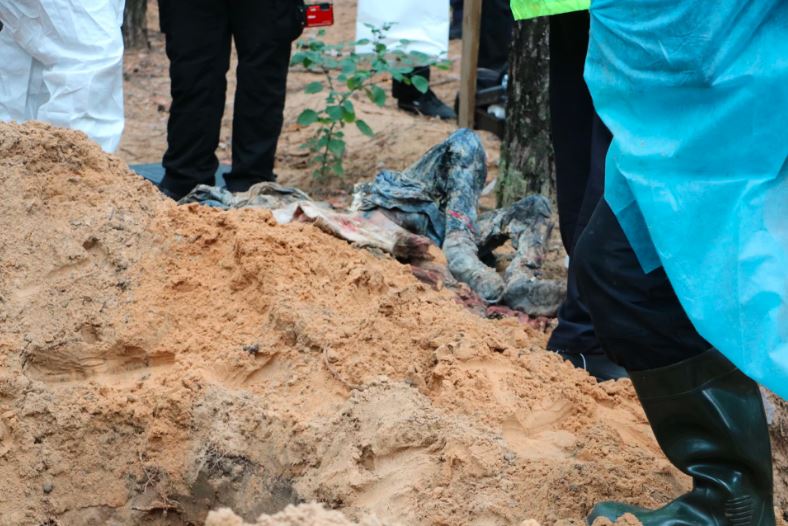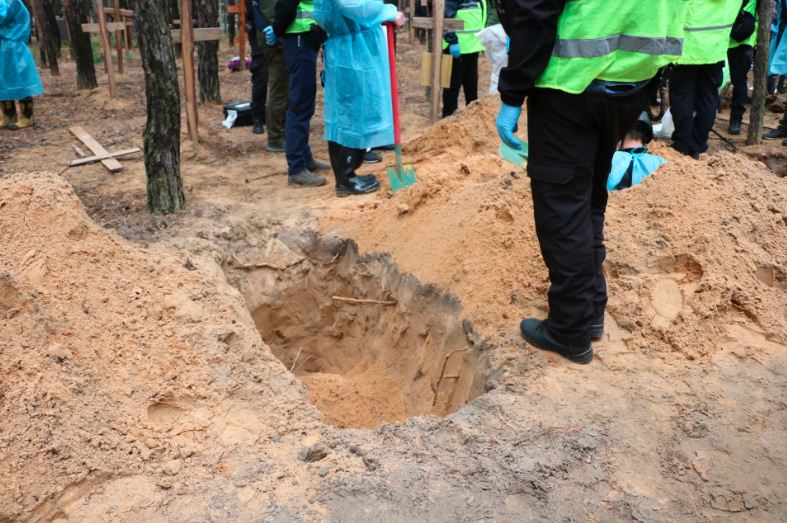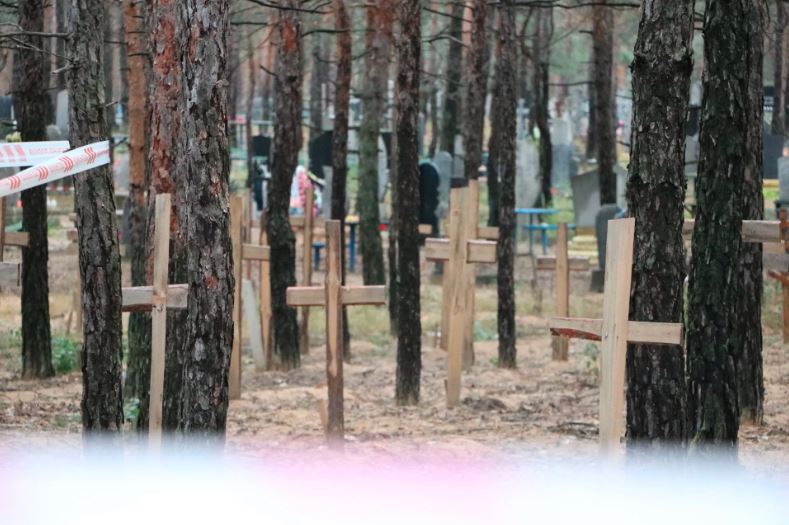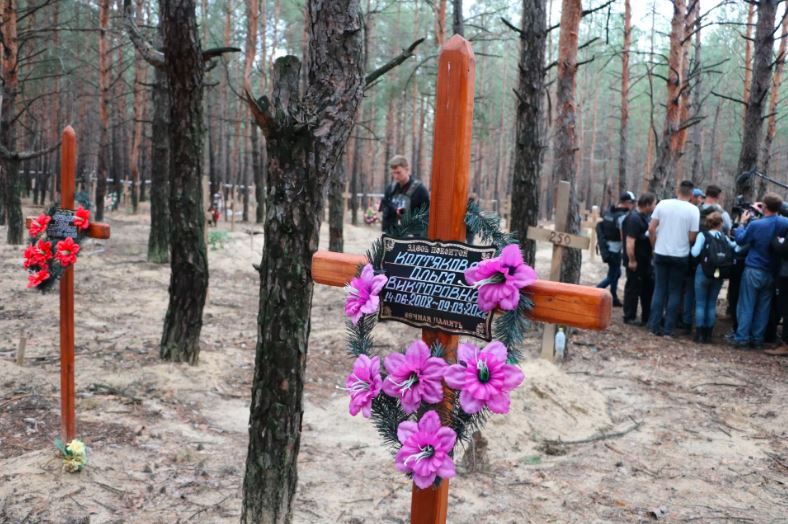121, 122, 123… Carelessly knocked together wooden crosses are marked with numbers. Their barely visible inscriptions blur into the vast pine forest encircling the city of Izium.
On the outskirts of this recently liberated city, smells of raw wood, rain, and crime mingle. Emergency workers in blue protection suits stand in blue protective suits. They tirelessly dig into the earth to exhume the bodies of the people buried underneath.
The bodies of roughly half a thousand Ukrainians have been discovered at this mass burial site, killed by the Russian occupiers. Most of the graves are nameless and some may have been there since March. The elderly, women, and children are among the buried civilians. Some lie wrapped in blankets, others are simply dressed in regular clothes.
It is September now. The bodies of the victims killed by the occupying Russian forces are being prepared for a dignified burial so that they may finally rest in peace.
All photos by Nadiya Sukha
Silent screams from graves in Izium
The burial site is situated at the end of a dirt track that leads into a forest. Emergency workers have already exhumed several dozens of graves. Signs of ordinary life peek through the sand and clay – somebody’s shoe, warm blankets, and shreds of civilian clothing.
“I have worked for the prosecutor’s office for a relatively long time and I have never seen anything like this. We saw this on TV when the war crimes in Bucha were being documented,” admitted Oleksandr Iliankov, Head of the Kharkiv District Prosecutor’s Office.
According to the police's preliminary count, there are more than five hundred people buried here.
The graves all look identical: two pinewood planks knocked together with nails to make a cross, marked with a number. Somebody was clearly in a hurry to cover up the gravity of their crimes and dispose of the lives and bodies they unlawfully took.
124,125, 126… "It’s like a concentration camp,” wraps up the Prosecutor.
Small wreaths hang on some of the crosses. One of them – purple in color – is damaged by the heavy rain. Some other crosses bear a surname and initials. While on others, the words “Here lies…. Day of death – 9th of March." On the 9th of March, the Russians bombarded a high-rise building which then collapsed and subsequently ended the lives of dozens of inhabitants.
Body to body “rests” a mother, father, and their baby. Russians gave every victim a number and a wooden cross.
Emergency workers pull out the coffins from the graves. Tortured bodies of innocent people, thin fingers raised in the air like a final plea for help. The terror and screams of the victims’ final moments have been frozen in time. Unlucky humans whose lives were ended by the Russians and who finally deserve to rest in peace.
Numbers in the register
At the end of the dirt track, an old man is seen crying. “My wife has never hurt a fly,” he sobs. His beloved wife was killed by Russian shelling. “I examined her straight away, touched her head, it was intact,”
he stutters.
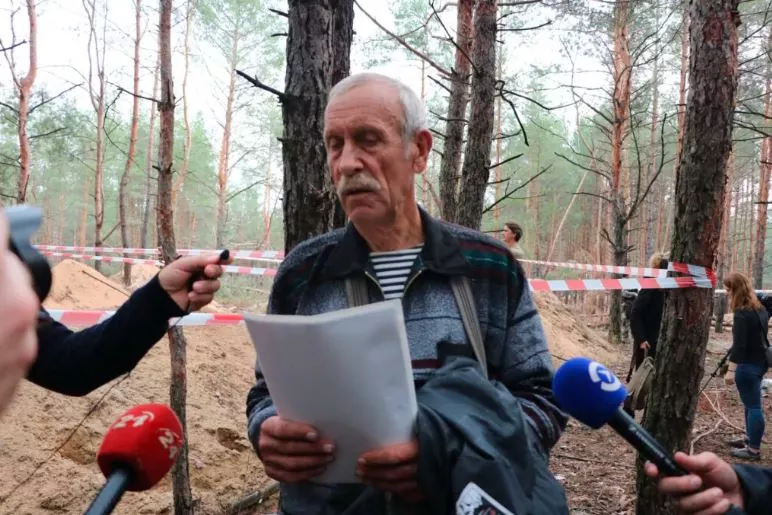
After his wife died, he buried her in his own backyard and later reburied her in the cemetery.
“Here lie my neighbors from the third floor. The entire family perished. The Yatseniuk family. Seven people,” Serhiy explains.
His voice is heavy but calm. Tired. His words are breaking off and his eyes are alive.
Serhiy lived in a high-rise building in Izium which no longer stands, after being hit by an enemy shell. Dozens of people have died in this house – under the rubble and in the fire. Serhiy and his mother were lucky to escape. His flat was destroyed.
“We were helping one woman down in the basement. For five days, we gave her food and water and ensured she was warm. Her name was Raisa, around 50-55 years old. Her hand was trapped. People were telling me: cut off the hand. I asked them: ‘are you insane?’ I may have cut off fingers before, but an entire hand – I’m not a doctor. One morning I went down to see her, but her eyes were already closed.”
Where are they now? In the forest? Not all of them. According to Serhiy’s words, some people have been completely burnt to death. A man with his neighbor helped to identify the bodies that were taken out from the ash.
“SIM cards were found, inserted, and checked for contacts. This was one way we could try to identify them. Others were identified by their clothes.”
At first, the locals themselves buried the dead. Some in yards, others – somewhere close by. Izium residents remember how some of the deceased continued to lie on the streets. And then the occupiers removed the bodies in a car with the inscription “Cargo 200.”
Serhiy explains that there are rumors among the locals that those bodies were buried in the forest.
Investigators say that the burials were carried out under the orders of the occupied administration.
“The person who was burying the bodies explained that those laid to rest were given a number. Later their relatives could confirm their relationship to the deceased and make a plaque,” says Serhiy Bulavinov, Head of the Kharkiv Region Police Investigative Unit.
Investigators confiscated a register where the Russians recorded the burials. Some of its lines contain data on the people who died because of Russian aggression. However, many records simply state “number X – unknown man.”
Cause of death: Ukrainian
A body lies in a white body bag. The silhouette of a person whose face can no longer be discerened. On the wrist, stretched out to the side, a blue and yellow armband is visible. An armband in the colors of the Ukrainian flag, worn by its owner in a grave for half a year, a grave dug by the occupiers. Here it is: body and soul laid down for our freedom, like in the Ukrainian anthem.
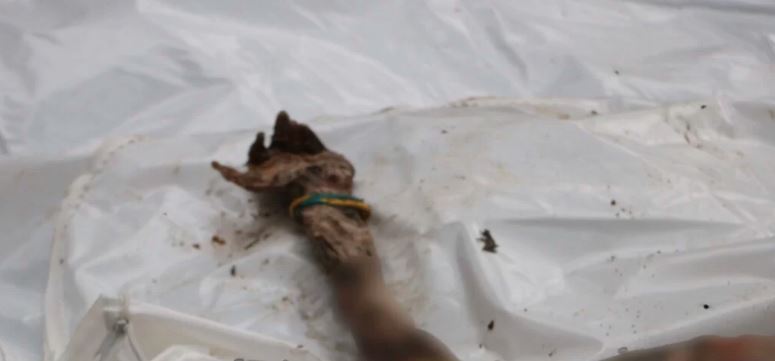
A further ten white body bags lie near the body. Each contains a human life lost.
Across from the mass burial site, the State Emergency Service of Ukraine finds another grave. This grave is without crosses. It is simply a giant hole where Russians dumped the bodies of killed Ukrainian soldiers. During the examination of the bodies, I see socks on the feet of a perished soldier. Information later surfaces in the mass media about the clothes and chevrons belonging to the “Holodonyarivtsi” (93rd Independent Kholodnyi Yar Mechanized Brigade).
At this cemetery, civilians and soldiers lie separately. But the occupiers were not kind to any of them.
“On some bodies, there are signs of torture. In the first grave, we found a body with a rope tied around the neck. I am sure signs of torture will be found during detailed forensic medical examinations on the bodies where none have been yet established during preliminary examinations," the prosecutor tells the journalists.
He adds that in some graves, the bodies of civilians had their hands tied.
Experts working near the mass grave seal a white body bag. It bears the inscription: “Unknown Soldier of the Armed Forces of Ukraine." I notice a girl leaning over a body. She has her eyes closed. It looks like she is praying. I would like to pray with her.
But I do not know any prayer which would ask God for a smaller price for our freedom.
The Ukrainian army kicked out the occupiers from Izium. But they did not vanish without a trace.
In the forest on the outskirts of the city, 445 graves have been dug out. In each lies at least one victim of Russian cruelty. Each contains evidence that the Russians are carrying out acts of pure evil.
The occupiers have left the dug-up trenches. A pit covered with pine trees and dirt is not immediately noticeable. Bystanders are not allowed to approach it – who knows what else the Russians left on our soil.
Here people lived and killed, here they covered up their crimes.
A light gust of wind brings the odor of dead flesh. It smells like torture. Smells like fear. Smells like Russia.
Related:
- Bodies of victims in deoccupied Izium are mutilated, have severed genitals – deputy minister
- Most bodies exhumed in Ukraine’s deoccupied Izium show signs of violent death – official
- Graves of 6 family members found at mass burial site in Izium
- Ukrainian troops enter Izium, Kharkiv Oblast (video)
- Ten torture chambers found in liberated Kharkiv oblast, six of them in Izium – Police



